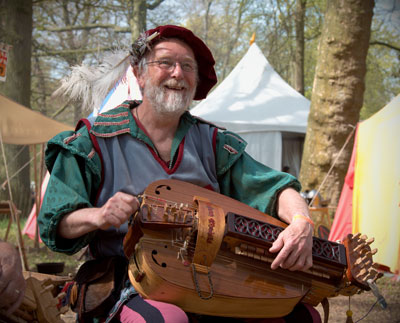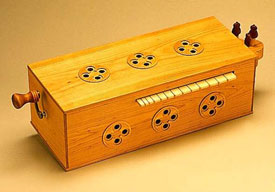 Hurdy-Gurdy
Hurdy-Gurdy
The hurdy-gurdy is a stringed instrument that produces sound by a crank-turned, rosined wheel rubbing against the strings. The wheel functions much like a violin bow, and single notes played on the instrument sound similar to those of a violin. Melodies are played on a keyboard that presses tangents—small wedges, typically made of wood—against one or more of the strings to change their pitch. Like most other acoustic stringed instruments, it has a sound board to make the vibration of the strings audible.
Most hurdy-gurdies have multiple drone strings, which give a constant pitch accompaniment to the melody, resulting in a sound similar to that of bagpipes. For this reason, the hurdy-gurdy is often used interchangeably or along with bagpipes, particularly in Occitan, Catalan, Sardinian, Cajun French and contemporary Galician and Hungarian folk music.
Many folk music festivals in Europe feature music groups with hurdy-gurdy players.

The hurdy-gurdy was the first stringed instrument to which the keyboard principle was applied. The French name, Viella a Roue (wheel fiddle), describes the method by which sound is produced. The bowing action of the fiddle is replaced by a wheel cranked by a handle. The outer rim of the wooden wheel is coated with resin. When the crank is spun, the wheel turns and the gut strings vibrate.
Just as the bag of the bagpipe acts as a reservoir of air for continuous sound, so too the wheel makes possible continuous sound by avoiding changes of bowing. Both bagpipe and hurdy-gurdy use drones, provided in the former by reed pipes, and in the latter by strings which sound fixed pitches. Other strings tuned in unison provide notes of the scale. Tangents activated by keys press these strings at the appropriate points to produce different pitches.
There is evidence of the hurdy-gurdy in Europe in the twelfth century. By the end of this century, the instruments was highly regarded. Before 1300 the instrument was often long enough to require two performers, one to crank, and one to push the keys. Single player instruments developed in the thirteenth century when the hurdy-gurdy became the ideal instrument for dance music.
|
Medieval Hurdy Gurdy |
Modern Hurdy Gurdy |

